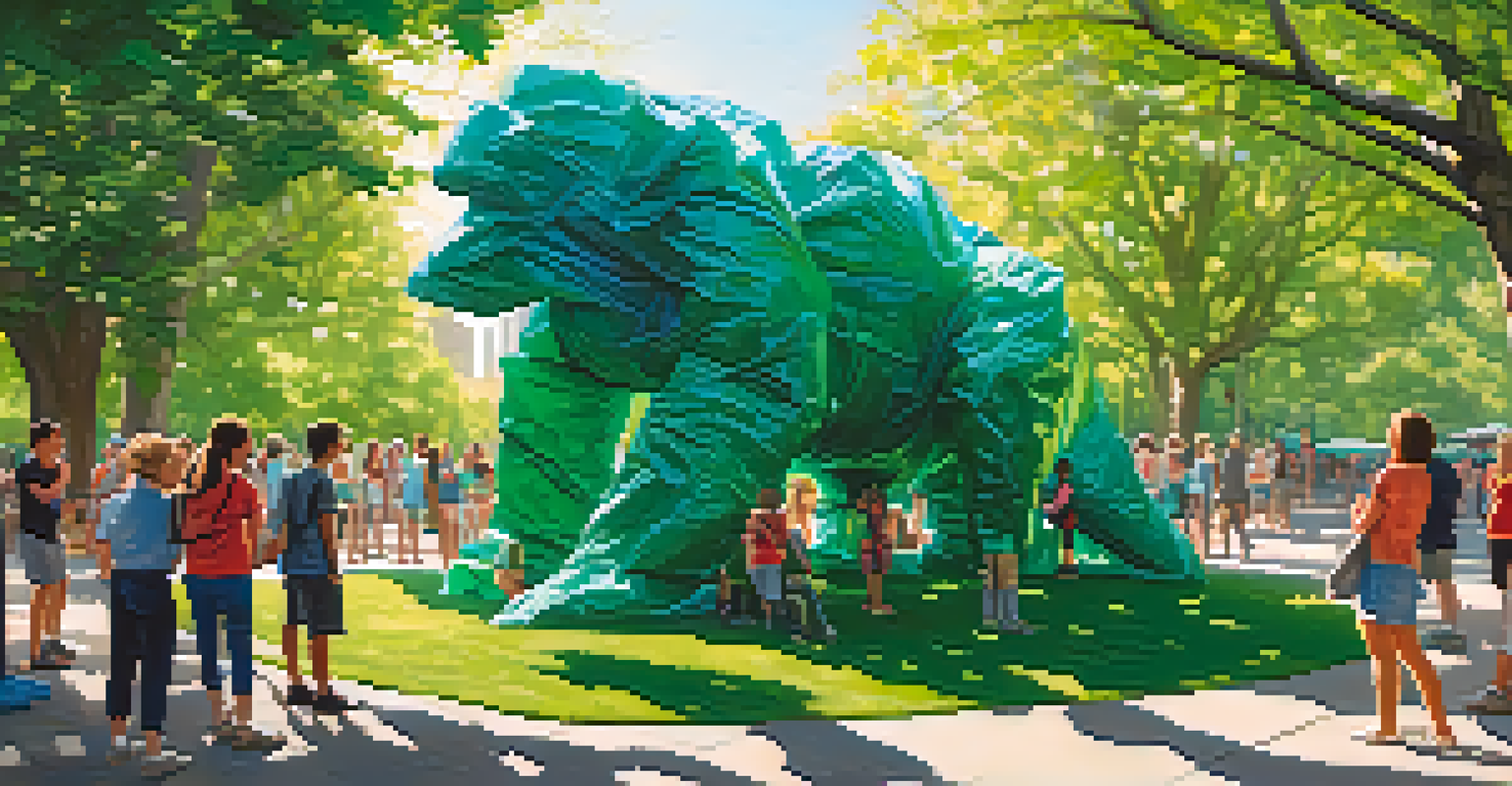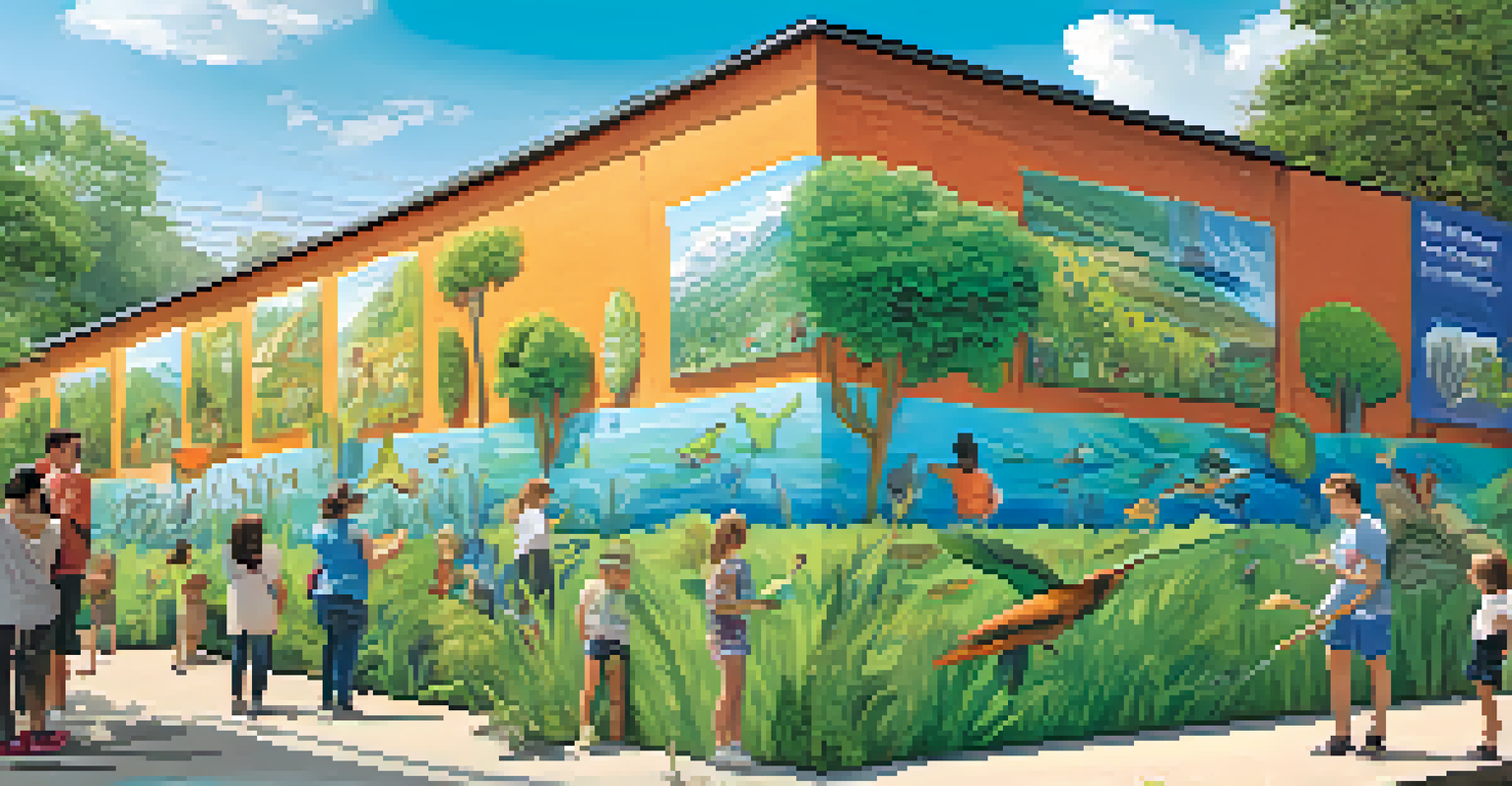Community Art Projects Fostering Climate Awareness Together

Understanding the Role of Art in Climate Awareness
Art has always been a powerful medium for expression, and its role in fostering climate awareness is no exception. Through visual storytelling, artists can communicate complex environmental issues in a way that resonates with people’s emotions. For example, a mural depicting melting glaciers can evoke feelings of urgency and concern that statistics alone might not convey.
Art is not freedom from discipline, but disciplined freedom.
When communities come together to create art, they not only raise awareness but also cultivate a sense of shared responsibility for the environment. This collaborative process allows individuals to express their thoughts and feelings about climate change, making the issue more relatable. Art becomes a vehicle for conversation, encouraging dialogue among diverse groups.
Furthermore, community art projects often invite participation from all ages and backgrounds, breaking down barriers to understanding climate issues. When everyone gets involved, it reinforces the idea that tackling climate change is a collective effort. The beauty of art lies in its ability to unite people toward a common goal, amplifying voices that might otherwise go unheard.
Examples of Successful Community Art Projects
There are numerous examples of community art projects that have successfully raised climate awareness. One notable initiative is the 'Ocean Mural Project,' where local artists painted murals on public buildings to illustrate the impact of plastic pollution on marine life. These murals not only beautify the neighborhood but also serve as constant reminders of the importance of ocean conservation.

Another inspiring project is the 'Climate Clock' installation in New York City, which visually represents the time left to combat climate change. This striking piece has sparked conversations about sustainability and urgency, making it a focal point for both locals and tourists. It has become a rallying cry for those advocating for environmental action.
Art as a Catalyst for Climate Action
Art serves as a powerful medium to foster climate awareness, connecting communities and evoking emotions related to environmental issues.
These projects highlight the creativity and passion that communities can harness to address climate issues. By blending art with activism, they create impactful visual messages that resonate widely. Such initiatives demonstrate that art can be a powerful tool for education and engagement in the fight against climate change.
Engaging Youth Through Art and Climate Education
Youth engagement is crucial in the fight against climate change, and art projects provide an excellent platform for inspiring young people. Programs that involve students in creating art about climate issues not only educate them but also empower them to take action. When kids see their artwork displayed publicly, it fosters a sense of ownership and responsibility toward their environment.
Every act of creation is first an act of destruction.
For instance, school districts have implemented art competitions focused on environmental themes, encouraging students to express their concerns creatively. These competitions not only showcase their artistic talents but also educate them about the importance of sustainability. The resulting artworks can be displayed in community centers or shared on social media, amplifying their message even further.
Moreover, collaborating with local artists during these projects provides mentorship opportunities for young creatives. They can learn about environmental science while honing their artistic skills, creating a holistic approach to education. This intersection of art and climate education cultivates a generation that is not only aware of climate issues but also equipped to advocate for change.
The Power of Public Installations in Raising Awareness
Public art installations can serve as powerful statements about climate change, often reaching audiences who might not engage with the topic otherwise. Large-scale installations, such as sculptures made from recycled materials, can draw attention and spark curiosity. When people encounter these artworks in their daily lives, it prompts reflection and conversation about sustainability.
Consider the 'Plastic Bag Monster,' a giant sculpture made entirely from discarded plastic bags. Displayed in public parks, this installation effectively illustrates the overwhelming amount of plastic waste in our environment. It captures the attention of passersby, many of whom may not have previously considered the impact of their consumption habits.
Youth Empowerment Through Art
Engaging youth in art projects about climate issues empowers them to take action and fosters a sense of responsibility for their environment.
By placing these thought-provoking pieces in high-traffic areas, communities can create a lasting impact. They encourage viewers to rethink their relationship with the environment and consider their role in protecting it. Public art transforms everyday spaces into platforms for awareness, making climate issues more visible and urgent.
Harnessing Social Media to Amplify Art and Awareness
In today’s digital age, social media plays a vital role in amplifying the messages of community art projects. Platforms like Instagram and TikTok allow artists to showcase their work to a global audience, spreading awareness about climate issues far beyond their local communities. A single post can inspire action and ignite conversations among diverse audiences.
For example, artists often share behind-the-scenes processes of their projects, highlighting the importance of sustainability in art. This transparency not only educates followers but also encourages them to participate in similar initiatives. By using hashtags related to climate action, these posts can reach individuals who are passionate about environmental issues, further expanding their reach.
Moreover, social media can serve as a tool for organizing local events, such as art workshops or exhibitions. By creating a community online, artists can mobilize support and encourage participation in climate awareness efforts. This interconnectedness demonstrates how art and technology can work hand-in-hand to foster a more sustainable future.
Creating Lasting Impact Through Collaborative Efforts
The true power of community art projects lies in their ability to create lasting impact through collaboration. When various stakeholders—artists, schools, local governments, and environmental organizations—work together, they can amplify their efforts and reach a broader audience. This synergy not only enhances the quality of the art but also strengthens community ties.
For instance, if a local school collaborates with an environmental group to create a mural, it can serve as both an artistic expression and an educational tool. The mural can depict local ecosystems, prompting discussions about conservation efforts. This collaboration fosters a sense of community ownership, encouraging residents to take pride in their environment.
Collaboration Enhances Impact
Collaborative community art projects amplify efforts to raise climate awareness, strengthening community ties and inspiring ongoing dialogue.
Ultimately, these collective endeavors can lead to sustained climate action beyond the art itself. By fostering connections among community members, they inspire ongoing dialogue about environmental issues. This continued engagement is essential for driving change and promoting sustainable practices in everyday life.
Future Directions for Community Art and Climate Awareness
Looking ahead, the intersection of community art and climate awareness is ripe for exploration. As communities grow increasingly concerned about the environment, there is a significant opportunity for artists to lead innovative projects that address these issues. By integrating technology and interactive elements, future art projects can engage audiences in new and exciting ways.
For example, augmented reality can be utilized to bring static artworks to life, allowing viewers to explore climate issues interactively. This immersive approach can deepen understanding and empathy, making the message more impactful. As artists experiment with new mediums, they can create experiences that resonate with younger audiences, ensuring that the message of climate awareness continues to evolve.

Furthermore, fostering partnerships with local businesses and organizations can enhance funding and resources for these initiatives. By rallying community support, artists can create projects that not only raise awareness but also inspire tangible action. The future of community art in climate awareness is bright, filled with possibilities for innovation and collaboration.